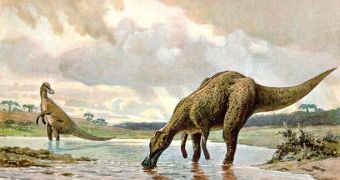Paleontologists excavating in Mexico have recently unearthed a dinosaur tail. Preliminary investigations have revealed that the tail most likely belonged to a Hadrosaur, a duck-billed dinosaur that walked the Earth some 72 million years ago.
Information shared with the public says that the tail was discovered in a desert located in the country's northern regions. The area where the fossils were found is named Coahulia.
People living in the region were the ones who first discovered the dinosaur's remains in June 2012.
Paleontologists were quick to arrive at the scene, yet excavations only debuted towards the beginning of this year's July.
This was because the researchers thought it was best to carefully survey the area before attempting to unearth the fossils.
What's interesting is that, according to the paleontologists who found it, the tail is pretty much intact.
Apparently, this is the first time when complete remains of a dinosaur have ever been discovered in Mexico.
The tail measures an impressive 16 feet (4.8 meters) in length, and it contains 50 vertebrae, The Examiner reports.
Since Hadrosaurs used to sport Tails that made up nearly half their entire body length, specialists estimate that the dinosaur to which this tail belonged was roughly 40 feet (12.2 meters) long.
Paleontologists expect that, following the discovery of this Hadrosaur tail, they will be able to gather more information concerning the anatomy of this dinosaur species.
They say that the fossils will help them shed new light on how it was exactly that a Hadrosaur moved its tail and the rest of its body when it was walking and running.
“For the biological study of dinosaurs this finding is important because we will have a sequence that will reveal the characteristics of the vertebrae. How they will be seen differentiating in size depends on their position in the spine,” paleontologists Angel Ramirez Velasco said, as cited by Red Orbit.
The same source informs us that, after being dug out, the fossils were sent to the city of General Cepeda. It is here where they will be thoroughly cleaned and inspected in further detail.

 14 DAY TRIAL //
14 DAY TRIAL //